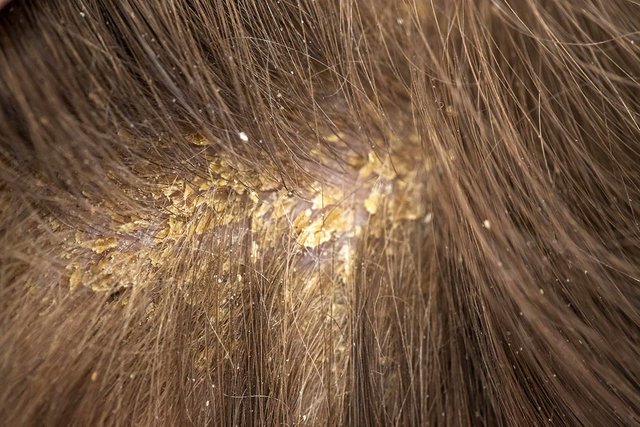CAUSES OF DANDRUFF
Although the exact cause of dandruff is unknown, it is presently thought that one of the main causes is a breakdown of the scalp's natural lipid barrier, exposing it to infection by microscopic yeast typically found in the scalp. When yeast overgrows, it triggers an inflammatory response that destroys a large number of scalp cells, causing them to slough off in sticky patches and flakes.
The following symptoms identify the condition:
– White or transparent flakes on the scalp, hair, and clothing.
– A scratchy, red, and irritated scalp.

Because their hygiene practices haven't altered to match the problems of newly rapid sebum production, some young teens acquire dandruff when they reach puberty.
Stress, poor cleanliness, and a bad diet can all contribute to dandruff on the scalp. Yeast infections are known to be exacerbated by high-sugar diets in particular.
Brushing the hair on a daily basis will release flakes and boost blood flow to the scalp, speeding up the body's natural immune reaction to infection.
TREATING DANDRUFF
To treat dandruff, there are a few behaviors you can acquire and natural therapies you can employ.
An excessive amount of sugar in the diet might worsen any yeast infection. While treating dandruff, try limiting your intake of all sugars and processed carbs.
When shampooing, massage your scalp thoroughly with your fingertips. This will aid in the loosening and removal of any dead skin flakes, as well as preventing the infection from spreading. Wash your hair every day until the infection is gone.
Use a protective hair conditioner solely on the ends of your hair. Conditioner should not be used to your scalp because it might block pores and impede skin recovery.
Other Therapies:
- Massage: Massaging your scalp with the pads of your fingers several times a day will stimulate blood flow to the hair follicles and loosen dead skin flakes.
-Brushing your hair on a daily basis will help loosen and eliminate dead skin flakes, enhance the smooth flow of sebum along the hair shaft, and increase blood supply to the hair follicles.
– After brushing and grooming your hair, wash your hands. Skin fungi are extremely contagious, and they are easy to reinfect and move to other parts of the body. This is why it's critical to wash your hair every day and brush out any loose dandruff flakes to avoid infecting healthy scalp areas.
It's also a good idea to wash your hands after brushing, massaging, and grooming your hair to avoid reinfection or cross infection.
The herbs and nutrients listed below have been proved to help with dandruff infections:
Internal Dandruff Treatments that are All-Natural
Natural blood sugar controllers include Alpha-Lipoic Acid, Vanadyl Sulfate, Gynema Sylvestre, and Chromium.
By maintaining normal blood sugar levels, it can help prevent the illness from spreading.
Olive leaf and oregano leaf are both natural antifungal agents with a systemic effect.
External Dandruff Treatments Made from Natural Ingredients
On a topical basis, the following plants can be used as a tonic to reduce fungal infections.
These herbs' extracts or a few drops of their essential oils diluted in aloe vera gel or witch hazel will considerably reduce the itching and flaking associated with dandruff. Tea tree oil is very useful in the treatment of bacterial and fungal diseases.
Clary Sage
Desert Sage
Eucalyptus
Fumitory
Ginkgo Biloba
Ginsen
Grapefruit Seed Extract
Grapefruit Essential Oil
Grapeseed Extract
Juniper Berry Essential Oil
Lavender Essential Oil
Lemongrass
Myrtle
Oregano
Poike Root
Thanks for visiting & reading.
Have a good day!
@ filiate07